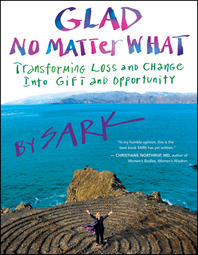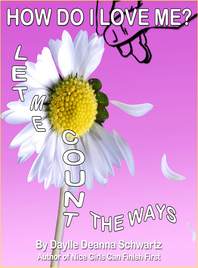 In December I had a guest article by SARK is a best-selling author and artist, with sixteen titles in print and well over two million books sold, including the national bestsellers Succulent Wild Woman, Bodacious Book of Succulence, Eat Mangoes Naked, Prosperity Pie, and Juicy Pens, Thirsty Paper. Her newest book is Glad No Matter What. SARK‘s books are very unique and they could uplift the dreariest of souls!
In December I had a guest article by SARK is a best-selling author and artist, with sixteen titles in print and well over two million books sold, including the national bestsellers Succulent Wild Woman, Bodacious Book of Succulence, Eat Mangoes Naked, Prosperity Pie, and Juicy Pens, Thirsty Paper. Her newest book is Glad No Matter What. SARK‘s books are very unique and they could uplift the dreariest of souls! How can we be glad when so many bad things are happening? How can we not? “Bad” things always have, and will always continue to happen. It is how we choose to respond that makes the difference. We all have an opportunity to respond to whatever is happening with as much gladness as possible, which will shift the very things that are happening. If you look at every bad or difficult situation, you will ALWAYS find the goodness and gladness. Focusing on that is what creates the real movement and solutions that we are all wanting.
Why are YOU so glad? I’m NOT all the time, just as much of the time as possible. I’m glad because I’m alive and well and able to contribute to the world and share love in significant ways. It’s not about the glass being half-full or empty, it’s about living with a glass that’s both. We can feel all of our feelings, and find gladness and joy more often. It’s not about finding the silver lining, as much as it is the rainbow lining, which includes all of our feelings, not just the glad ones. Paradoxically, this creates more gladness.
In what specific ways can we all be more glad? Feel what you feel when you feel it, then let that go. This will open the channels for more gladness. Look for things to be glad about, and talk about them, write then down, celebrate them. This will call more gladness to you. Make your most “alive choices” which are the ones that are a little scary, or make you a little nervous. These are the things that will fill your soul, and in turn fill the soul of the world. Do your transformative practices, which means taking whatever happens, and finding new ways to respond, and continue to practice–telling and living new stories. This means that you stop repeating and reliving negative incidents, and instead focus on retelling the great and good things. This will cause and create more goodness and gladness.
Why this book now? We are all seeking better ways to live and love our lives and assist the world in being a more creative, nourishing, and glad place. This book demonstrates how I do that, and gives powerful stories and examples of how you can do that. Here are a few examples; facing a 3-hour flight delay, I built a fort in the airport. Being at the DMV with a lot of unhappy people, I stood up and sang Amazing Grace. Hearing that I was being audited, I transformed fear and worry into a great exchange with the IRS agent who cried because she said no one had ever been that kind to her.
What was your biggest inspiration for writing this book? The deaths of my mother and cat, and the end of a romantic relationship formed the initial reason for writing the book, but transformation is always my greatest inspiration, and how we can literally “change the form” of what happens to us and what we do with that, is the basis of this book. All of my changes and losses have been transformed into gifts and opportunities, and those gifts and opportunities create more GOODNESS and GLADNESS to share with the world.
Can one really be “glad no matter what”? Yes. By finding the glad parts in WHATever happens, and doing our transformational practices. We will still feel all of our feelings; we will just be invited not to spend so much time there. By feeling what we feel when we feel it, we can learn to better hold multiple feelings, and find the glad parts in as many of them as possible.
What losses have you transformed into gifts or opportunities? I was molested by a family member and transformed it into compassion and forgiveness. The death of my mother was transformed into feelings of unconditional love and gladness that she lived, and that she was my mom. The death and physical loss of my cat showed me that his unconditional love lives within me, and that I now share that with the world. The loss of youth has and is being transformed into wisdom and self-love that is profound and life changing. The loss of money has transformed into knowing that our true wealth does not lie in the material, but the spiritual. The changes in my business have resulted in entirely new uses of technology and creativity.
You say that whatever is happening, we have the opportunity to practice centering ourselves. What does that mean and how do we do it? By doing our transformative practices, we can choose to respond to what is happening instead of reacting. We can allow whatever is, instead of resisting what we say we don’t want. We center ourselves by knowing that whatever is happening, it is external. We go within and center in the internal. This will create calm, compassionate responses to outside circumstances. And when we forget and react instead, we know that our transformative practices will lead us back to our truer nature responses. Here is a recent example; A driver was late in picking me up to drive me to the airport. Rushing to meet him, I slipped in cat poop and fell down. He greeted without explanation or acknowledgement about being late. I reacted defensively and so did he. I considered not riding with him as part of my reaction. Instead I sat in the back of the car staring at the back of his head, disliking him. Then I went within and responded differently and asked if we could start over. We ended up forgiving each other and hugging and crying at the airport.
What is the middle place? How do we get there? The middle place is in between the extremes of our emotions. It’s where we can find our greatest centering and compassion. The middle place is messy and full of multiple feelings. It’s not concerned with “being right.” It’s where we might say; “I’m disappointed that my friend didn’t _____, but I love him/her and choose to think the best about it.” We get there by going within before responding and choosing not to quickly react to outside circumstances. And when we forget, we go to the middle place to find our calm, compassionate responses.
You encourage your readers to go towards the broken, dark, and difficult places. Why? Avoiding them doesn’t work. It is very tempting to avoid, deny, lie, and create cover ups. It seems to work in the short term, but it accrues and causes tremendous damage later. Time does not heal anything either without applied transformative practices. I
know this because I tried everything not to feel the darker, more difficult feelings. Then I attempted suicide and woke up to really begin my transformative practice work. We need to feel everything. We can use a flashlight to look at the darkness and get help to support us. We can learn not to dwell in repetitive negative stories and live with life-long grudges. We can do our transformative practices now and all of our lives and live in a much more self-loving, self-caring way.
What will being glad really DO for people? It fills them from the inside, so that they become and live like “full cups of self-love and gladness” sharing the overflow with the world.
What’s a miracle walk? How do you do one? A miracle walk is where you walk out of your house or wherever you are, and be wanting or willing to experience miracles. You put your palms up and say; “Miracles find me now.” Then you walk until a miracle occurs. Learn to recognize miracles; they don’t always look like what they are. They could be disguised in some way. For example, you might encounter a person yelling wearing tattered clothing. In speaking with the person, you might experience the miracle of your own heart opening to someone suffering.
What’s the “glad game?” It originated with Eleanor Porter’s book Pollyanna. Pollyanna was a young girl whose parents died and she was sent to live with relatives in a small town that she didn’t know. Her relatives were less than kind and the town unwelcoming. Pollyanna invented the glad game to play with everyone she met. In time, her relatives and the whole town transformed. In this way, we can all play the glad game with our lives. With whatever is happening, we can feel our feelings, and then find the good and glad that’s there, and share that too. For example, my friend just had a car accident on the freeway and her car was totaled and she had no collision insurance. She was shocked, scared, worried and angry. She was also grateful not to be physically injured and glad that I came to help her. Later she was even more glad that her estranged father appeared in her life and helped her to get a replacement car.
What’s the biggest difference between this book and the first book you wrote/published? The fact that I’ve been doing my transformative practices for 20 years and it shows in my ability to live “in the middle,” and live like a full cup of self-love and gladness, sharing the overflow with the world. That I practice feeling all of my feelings, fully, as much as possible, and that I can show others how and why to do the same. That I’m a “transformative change agent,” actively living and practicing what I’m writing about.
SARK is also the founder and CEO of Planet SARK, a thriving business that creates innovative products and services to support empowered living. She lives and creates in San Francisco, CA. Visit her online at http://www.planetsark.com. And check out her book, Glad No Matter What.
Please leave comments under my posts so we can stay connected.

